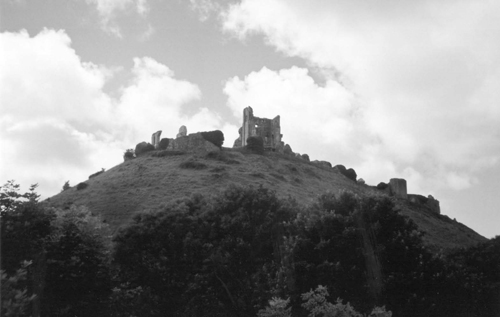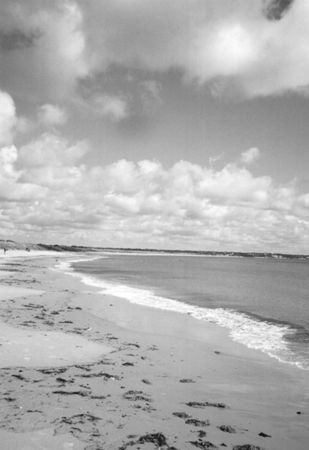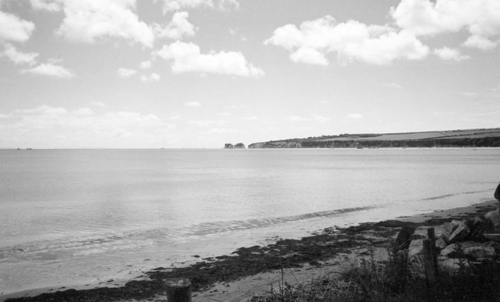Under the Bloody Flag (38 page)
Read Under the Bloody Flag Online
Authors: John C Appleby


Corfe Castle, Dorset. The estate of the castle was acquired by Sir Christopher Hatton in 1572. During the early 1580s the keeper of the castle, Francis Hawley, warned one of the Queen’s ministers that he was unable to prevent pirates from visiting the region. The castle was occasionally used to stage trials for pirates. (Author’s collection)
The damaging impact of disorderly plunder and piracy aroused widespread concern. One report partly blamed the decline of Southampton on piracy. During the past ten years it was claimed that pirates had haunted the coast. They seized many ships bound for the port, disposing of their plunder locally and in other parts of the county. The pirates ‘robbed & spoyled many of our merchants even at their owne dores, & sold away their goods as it were before their own faces, to the undoing of many which shall never be able to recover themselves againe’.
88
In addition, the upsurge of Scottish piracy was particularly damaging for trade and fishing along the east coast. By June 1584 Scots pirates had taken more than fourteen vessels belonging to the fishing ports of Suffolk. Later in the year, North and South Shields claimed to have suffered damages amounting to £1,100 at their hands. Concern at the activities of the Scots was accompanied by complaints from the coastal communities of the south-east against Dutch men-of-war, including the ‘hell-hounds’ of Flushing.
89
Although the economic cost is impossible to quantify, the damage inflicted on English trade and shipping by overseas pirates and privateers may have been considerable. During Anglo-French negotiations concerning the plunder of shipping in the 1590s, the English claimed losses against the French of £104,000, of which ‘there was never one penie restitution made’.
90
More than one quarter of the total value of this spoil was taken during the first half of the 1580s, with losses of more than £17,000 during 1580 and 1581, followed by a sharp drop, before the amount began to increase during 1584.
The scale of cross-Channel plunder and reprisals rendered redundant a renewed Anglo-French attempt to agree on articles for the abolition of piracy during 1583. French complaints concerning the activities of Hellebourg and Callice appear to have persuaded the regime to send out Captain Richard Bingham in September with a commission to take pirates in the Channel, though in reality it may have been a cover for the seizure of Dutch vessels as recompense for outstanding debts. This did little to ease French hostility at sea. The violence and disorder were inflamed by reports of cases such as the seizure of a Breton vessel by Henry Knollys, which rotted away at Southampton, while its owner went mad and died pursuing the case in the High Court of Admiralty, leaving behind a widow and children in starving circumstances.
91
The seas around the British Isles consequently remained profitable hunting grounds for pirates and privateers of varying background and legality. Some regions were infested with rovers. Within a few days of leaving the Thames, Fenton’s expedition encountered more than six suspicious ships, two of which were taken and brought into Southampton as prizes. Off Dover it met four small vessels which were suspected to be men-of-war. One was a pirate ship, manned with at least nine men who were originally recruited for the expedition, but who abandoned it in favour of piracy, when Frobisher was replaced by Fenton. Under Captain Watson – and with Willobye, ‘a tawl [bold] feloe of Dover’, among the company – the pirates seized a vessel which they later exchanged for a Flemish ship.
92
As Fenton’s fleet sailed from Dover to Southampton, it met and chased two vessels under the command of Captain Heyns, a notorious pirate. It also stopped and boarded a man-of-war, sailing under a commission from Don Antonio, with a French prize. As the expedition approached Southampton it was boldly greeted by Captain Clarke with his customary salute of a glass of wine.
The pirate groups operating during these years were led by a mix of experienced and well-established captains, some of whom, like Callice or Clarke, had been active for more than a decade, while there existed a group of younger leaders, including Clinton Atkinson and Thomas Walton of Cheshire, alias Clinton and Purser. In March 1583 Clinton was spoiling vessels at the mouth of the River Shannon, in a ship of 100 tons and with a company of eighty men. A few months later, he was reported to have seized one of the Queen’s vessels, defiantly threatening to enter the service of the King of Spain or to support the rebellion of Gerald Fitzgerald, 15
th
Earl of Desmond, in Ireland. Towards the end of the year, in consortship with Atkinson, he plundered several Irish ships in Mount’s Bay. One of the victims, Maurice Fowler of Cork, was subsequently awarded a licence to beg, as a means of alleviating his losses.
93
Despite the plunder of Irish shipping by Clinton and Purser, English pirates and rovers received varied support in the remote regions of south-west Ireland, renewing contacts which were to flourish during the early seventeenth century. As in parts of England and Wales piracy encouraged the growth of widespread, if sporadic, networks of trade, exchange and gift giving. Along the isolated and rough hewn coast of Munster pirates were provisioned and provided with recruits, many of whom came from transient groups of seafarers and fishermen. The presence of an increasing number of soldiers in Ireland created a wider pool of potential recruits. It was a mixed group of soldiers and sailors, for example, who plundered a vessel in the harbour at Youghal during 1580. The discharge of soldiers in Ireland, many of whom lacked the resources to return to England, dramatically increased the number of poor and vagrant in some communities. According to a report of February 1582, unemployed soldiers were begging on the streets of Dublin.
94
Such conditions favoured the growth of organized, though petty, criminality both on land and at sea.
On the eve of the outbreak of the war with Spain, therefore, conditions at sea were profoundly confused. Localized piracy, indiscriminate and opportunistic in character, remained a serious problem, with the connivance or cooperation of shore-based supporters. During March 1584 officials in Poole, including the mayor, faced allegations of dealing with pirates. In 1585 the inhabitants of Lydd were accused of relieving rovers, including Atkinson. The regime appointed another commission to investigate piracy in the south-west during 1584, while Drake and Carew Raleigh were authorized to apprehend pirates at sea. In October Sir Julius Caesar drew up proposals for combating piracy, partly in response to complaints from merchants of Aberdeen, in favour of leaving the problem to be dealt with by the Lord Admiral and the judge of the High Court of Admiralty, whose powers were to be enhanced. Although the proposals were not adopted immediately, Caesar’s own admiralty circuit in the south-west during the early 1590s demonstrated what might be achieved with closer supervision.
95
Yet one of the underlying problems was the peculiar criminal characteristics of piracy. While it often began in violent and random circumstances, for many it was casual, part-time employment. It attracted recruits of varied backgrounds, especially mariners and men from related occupations, including soldiers and other landsmen. Robert Titley, a soldier from Blandford in Dorset, served with Callice and Hellebourg during the early 1580s. Aged about thirty-four or thirty-five, he was to sail on many other voyages thereafter. By 1592 he had acquired ten or twelve years’ experience of the sea, including service on reprisal ventures into the Caribbean.
96
At times piracy could be portrayed as a contested crime, with extensive social roots, which was driven or justified by economic necessity. The testimony of a group of men who were arrested and accused of piracy during 1584 illustrates the difficulty in trying to police an organized form of petty but popular criminality, which combined robbery and force with good fellowship. The oldest member of the group, Richard Thomas, a fisherman of Penryn, aged about fifty, insisted that he was taken by the pirate, Charles Jones, while fishing in Falmouth haven with two men and a boy. John Harris, a boy aged about fourteen, claimed that he was detained by the pirates in Studland Bay, and employed as their cook. At least two other men joined the company at Studland, including John Deamon of London, a sailor aged about thirty, and John Adams of Christchurch, a labourer of similar age, who went aboard Jones’ ship ‘hoping to fynd some frindshipp there’.
97
In addition, William Glover of Bideford, a husbandman aged about twenty-four, was recruited while serving in a fishing boat in the west. Robert Hawley of Ipswich, a sailor aged about twenty-one, joined Jones’ company at Kinsale.
This pattern of recruitment and venturing was one of the defining features of local piracy during these years. Jones and his company were involved in a voyage that lasted for about one month, during which they seized a vessel laden with alum, wax and other commodities, near Newhaven along the coast of France. Thereafter the pirates sailed for Ireland where the booty was exchanged for provisions. Following a conflict with another French ship, when one of the pirates was killed and thirteen others were wounded, Jones returned to England. According to Thomas, while the pirate ship was anchored in Stokes Bay it was supplied with provisions of beef, mutton, wine and bread by boats from Portsmouth and Hamble. The pirates were chased by Captain Gilbert Yorke in one of the Queen’s ships, and at least six of the company were captured, though Jones and twelve others escaped ashore.
98
The persistence of such forms of piracy and sea roving encouraged the development of varied practices and patterns of behaviour among pirate groups. While the bravado of some pirate captains reflected the ethos of young, masculine and potentially violent groups, it may also have represented a rejection of respectable society, or at least that part of it which was concerned to promote moral reform. The behaviour of captains like Clarke flaunted the good fellowship and comradeship aboard pirate ships. At the same time it may have been intended to mimic and mock social convention. One of the associates of John Piers, for example, who was described as a ‘very eavell disposed mane’, claimed that the Queen was his godmother.
99
Pirate agency may have been an appealing and subversive force, as well as a means of acquiring wealth. It was manifested in various ways; moreover its creative energy was probably inspired by the rich oral culture which bound seafaring communities together. During Fenton’s voyage, for example, Madox recounted the ‘good sport’ he and others had, from listening to the surgeon recite ‘Robynhood rymes’.
100
Tales and rhymes provided entertainment at sea, encouraging friendship and community, but they were also a way of circulating ideas, sometimes to promote or justify piracy and spoil.

Studland Bay, Dorset. This wide arcing bay served as a safe haven for a large number of pirates during the 1570s and early 1580s. At least forty prizes taken by pirates were brought in during the early 1580s, attracting dealers from a wide hinterland. (Author’s collection)

